毕业论文 外文翻译格式
- 格式:docx
- 大小:3.46 KB
- 文档页数:2
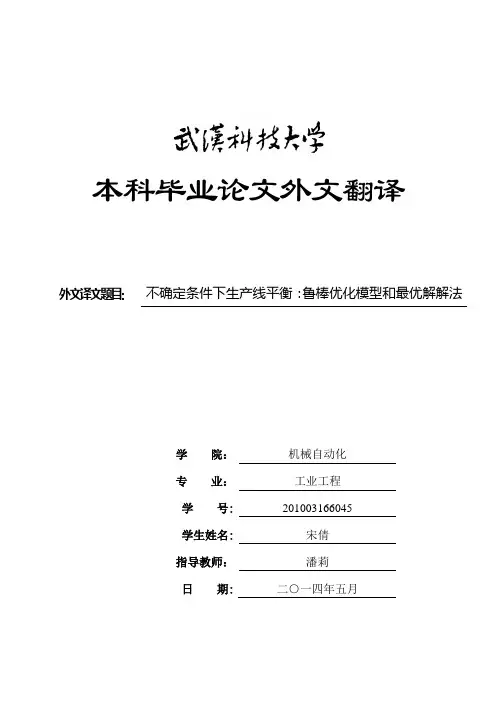
本科毕业论文外文翻译外文译文题目:不确定条件下生产线平衡:鲁棒优化模型和最优解解法学院:机械自动化专业:工业工程学号: 201003166045学生姓名: 宋倩指导教师:潘莉日期: 二○一四年五月Assembly line balancing under uncertainty: Robust optimization modelsand exact solution methodÖncü Hazır , Alexandre DolguiComputers &Industrial Engineering,2013,65:261–267不确定条件下生产线平衡:鲁棒优化模型和最优解解法安库·汉泽,亚历山大·多桂计算机与工业工程,2013,65:261–267摘要这项研究涉及在不确定条件下的生产线平衡,并提出两个鲁棒优化模型。
假设了不确定性区间运行的时间。
该方法提出了生成线设计方法,使其免受混乱的破坏。
基于分解的算法开发出来并与增强策略结合起来解决大规模优化实例.该算法的效率已被测试,实验结果也已经发表。
本文的理论贡献在于文中提出的模型和基于分解的精确算法的开发.另外,基于我们的算法设计出的基于不确定性整合的生产线的产出率会更高,因此也更具有实际意义。
此外,这是一个在装配线平衡问题上的开创性工作,并应该作为一个决策支持系统的基础。
关键字:装配线平衡;不确定性; 鲁棒优化;组合优化;精确算法1.简介装配线就是包括一系列在车间中进行连续操作的生产系统。
零部件依次向下移动直到完工。
它们通常被使用在高效地生产大量地标准件的工业行业之中。
在这方面,建模和解决生产线平衡问题也鉴于工业对于效率的追求变得日益重要。
生产线平衡处理的是分配作业到工作站来优化一些预定义的目标函数。
那些定义操作顺序的优先关系都是要被考虑的,同时也要对能力或基于成本的目标函数进行优化。
就生产(绍尔,1999)产品型号的数量来说,装配线可分为三类:单一模型(SALBP),混合模型(MALBP)和多模式(MMALBP)。
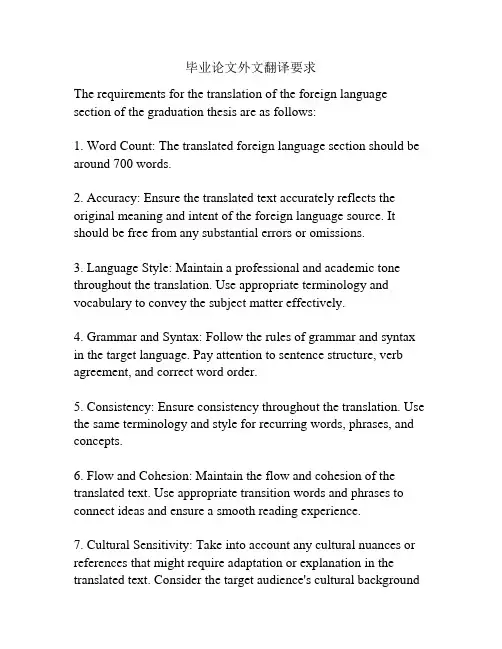
毕业论文外文翻译要求The requirements for the translation of the foreign language section of the graduation thesis are as follows:1. Word Count: The translated foreign language section should be around 700 words.2. Accuracy: Ensure the translated text accurately reflects the original meaning and intent of the foreign language source. It should be free from any substantial errors or omissions.3. Language Style: Maintain a professional and academic tone throughout the translation. Use appropriate terminology and vocabulary to convey the subject matter effectively.4. Grammar and Syntax: Follow the rules of grammar and syntax in the target language. Pay attention to sentence structure, verb agreement, and correct word order.5. Consistency: Ensure consistency throughout the translation. Use the same terminology and style for recurring words, phrases, and concepts.6. Flow and Cohesion: Maintain the flow and cohesion of the translated text. Use appropriate transition words and phrases to connect ideas and ensure a smooth reading experience.7. Cultural Sensitivity: Take into account any cultural nuances or references that might require adaptation or explanation in the translated text. Consider the target audience's cultural backgroundand adapt the language accordingly.8. Formatting: Format the translated text to match the formatting requirements of the graduation thesis. Ensure proper indentation, paragraph spacing, and font style.9. Proofreading: Thoroughly proofread the translated text to identify and correct any typos, spelling errors, or grammatical mistakes.10. Delivery: Submit the translated foreign language section within the specified deadline. Provide the translated text in a compatible format, such as a Word document or PDF file.By adhering to these requirements, the translated foreign language section of the graduation thesis will meet the desired standards of quality and accuracy.。
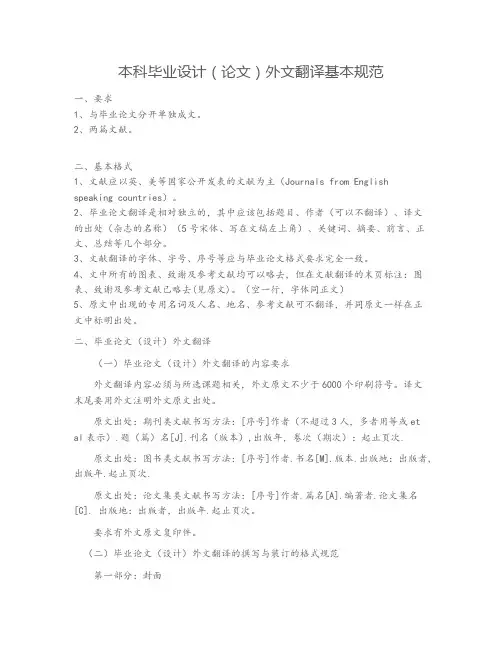
本科毕业设计(论文)外文翻译基本规范一、要求1、与毕业论文分开单独成文。
2、两篇文献。
二、基本格式1、文献应以英、美等国家公开发表的文献为主(Journals from English speaking countries)。
2、毕业论文翻译是相对独立的,其中应该包括题目、作者(可以不翻译)、译文的出处(杂志的名称)(5号宋体、写在文稿左上角)、关键词、摘要、前言、正文、总结等几个部分。
3、文献翻译的字体、字号、序号等应与毕业论文格式要求完全一致。
4、文中所有的图表、致谢及参考文献均可以略去,但在文献翻译的末页标注:图表、致谢及参考文献已略去(见原文)。
(空一行,字体同正文)5、原文中出现的专用名词及人名、地名、参考文献可不翻译,并同原文一样在正文中标明出处。
二、毕业论文(设计)外文翻译(一)毕业论文(设计)外文翻译的内容要求外文翻译内容必须与所选课题相关,外文原文不少于6000个印刷符号。
译文末尾要用外文注明外文原文出处。
原文出处:期刊类文献书写方法:[序号]作者(不超过3人,多者用等或et al表示).题(篇)名[J].刊名(版本),出版年,卷次(期次):起止页次.原文出处:图书类文献书写方法:[序号]作者.书名[M].版本.出版地:出版者,出版年.起止页次.原文出处:论文集类文献书写方法:[序号]作者.篇名[A].编著者.论文集名[C]. 出版地:出版者,出版年.起止页次。
要求有外文原文复印件。
(二)毕业论文(设计)外文翻译的撰写与装订的格式规范第一部分:封面1.封面格式:见“毕业论文(设计)外文翻译封面”。
普通A4纸打印即可。
第二部分:外文翻译主题1.标题一级标题,三号字,宋体,顶格,加粗二级标题,四号字,宋体,顶格,加粗三级标题,小四号字,宋体,顶格,加粗2.正文小四号字,宋体。
第三部分:版面要求论文开本大小:210mm×297mm(A4纸)版芯要求:左边距:25mm,右边距:25mm,上边距:30mm,下边距:25mm,页眉边距:23mm,页脚边距:18mm字符间距:标准行距:1.25倍页眉页角:页眉的奇数页书写—浙江师范大学学士学位论文外文翻译。
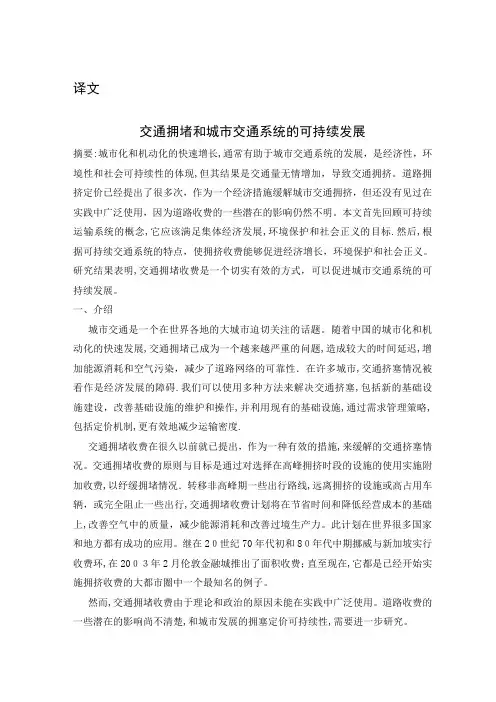
译文交通拥堵和城市交通系统的可持续发展摘要:城市化和机动化的快速增长,通常有助于城市交通系统的发展,是经济性,环境性和社会可持续性的体现,但其结果是交通量无情增加,导致交通拥挤。
道路拥挤定价已经提出了很多次,作为一个经济措施缓解城市交通拥挤,但还没有见过在实践中广泛使用,因为道路收费的一些潜在的影响仍然不明。
本文首先回顾可持续运输系统的概念,它应该满足集体经济发展,环境保护和社会正义的目标.然后,根据可持续交通系统的特点,使拥挤收费能够促进经济增长,环境保护和社会正义。
研究结果表明,交通拥堵收费是一个切实有效的方式,可以促进城市交通系统的可持续发展。
一、介绍城市交通是一个在世界各地的大城市迫切关注的话题。
随着中国的城市化和机动化的快速发展,交通拥堵已成为一个越来越严重的问题,造成较大的时间延迟,增加能源消耗和空气污染,减少了道路网络的可靠性.在许多城市,交通挤塞情况被看作是经济发展的障碍.我们可以使用多种方法来解决交通挤塞,包括新的基础设施建设,改善基础设施的维护和操作,并利用现有的基础设施,通过需求管理策略,包括定价机制,更有效地减少运输密度.交通拥堵收费在很久以前就已提出,作为一种有效的措施,来缓解的交通挤塞情况。
交通拥堵收费的原则与目标是通过对选择在高峰拥挤时段的设施的使用实施附加收费,以纾缓拥堵情况.转移非高峰期一些出行路线,远离拥挤的设施或高占用车辆,或完全阻止一些出行,交通拥堵收费计划将在节省时间和降低经营成本的基础上,改善空气中的质量,减少能源消耗和改善过境生产力。
此计划在世界很多国家和地方都有成功的应用。
继在20世纪70年代初和80年代中期挪威与新加坡实行收费环,在2003年2月伦敦金融城推出了面积收费;直至现在,它都是已经开始实施拥挤收费的大都市圈中一个最知名的例子。
然而,交通拥堵收费由于理论和政治的原因未能在实践中广泛使用。
道路收费的一些潜在的影响尚不清楚,和城市发展的拥塞定价可持续性,需要进一步研究。
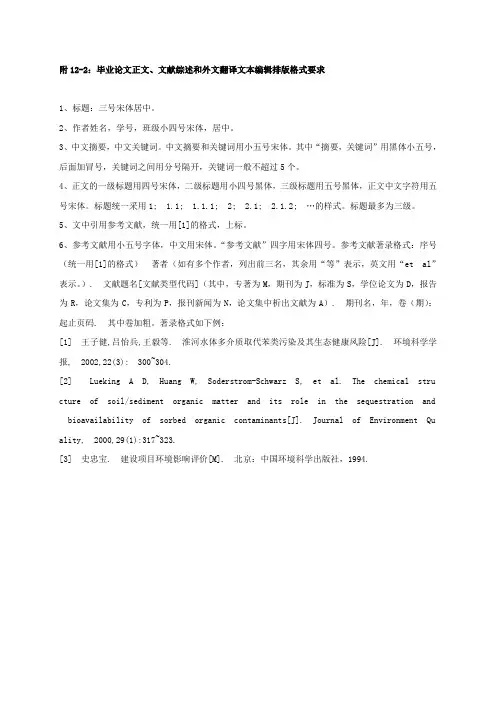
附12-2:毕业论文正文、文献综述和外文翻译文本编辑排版格式要求1、标题:三号宋体居中。
2、作者姓名,学号,班级小四号宋体,居中。
3、中文摘要,中文关键词。
中文摘要和关键词用小五号宋体。
其中“摘要,关键词”用黑体小五号,后面加冒号,关键词之间用分号隔开,关键词一般不超过5个。
4、正文的一级标题用四号宋体,二级标题用小四号黑体,三级标题用五号黑体,正文中文字符用五号宋体。
标题统一采用1; 1.1; 1.1.1; 2; 2.1; 2.1.2; …的样式。
标题最多为三级。
5、文中引用参考文献,统一用[1]的格式,上标。
6、参考文献用小五号字体,中文用宋体。
“参考文献”四字用宋体四号。
参考文献著录格式:序号(统一用[1]的格式)著者(如有多个作者,列出前三名,其余用“等”表示,英文用“et al”表示。
). 文献题名[文献类型代码](其中,专著为M,期刊为J,标准为S,学位论文为D,报告为R,论文集为C,专利为P,报刊新闻为N,论文集中析出文献为A). 期刊名,年,卷(期):起止页码. 其中卷加粗。
著录格式如下例:[1] 王子健,吕怡兵,王毅等. 淮河水体多介质取代苯类污染及其生态健康风险[J]. 环境科学学报, 2002,22(3): 300~304.[2] Lueking A D, Huang W, Soderstrom-Schwarz S, et al. The chemical structure of soil /sediment organic matter and its role in the sequestration and bioavailability of sorb ed organic contaminants[J]. Journal of Environment Quality, 2000,29(1):317~323. [3] 史忠宝. 建设项目环境影响评价[M]. 北京:中国环境科学出版社,1994.。
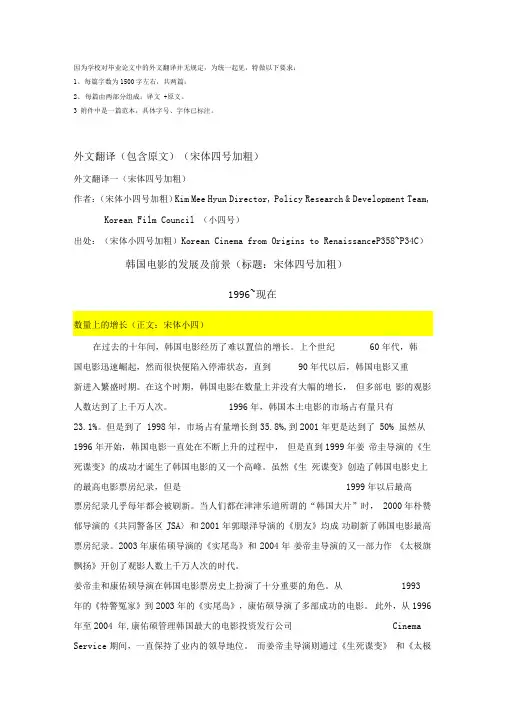
因为学校对毕业论文中的外文翻译并无规定,为统一起见,特做以下要求:1、每篇字数为1500字左右,共两篇;2、每篇由两部分组成:译文 +原文。
3 附件中是一篇范本,具体字号、字体已标注。
外文翻译(包含原文)(宋体四号加粗)外文翻译一(宋体四号加粗)作者:(宋体小四号加粗)Kim Mee Hyun Director, Policy Research & Development Team, Korean Film Council (小四号)出处:(宋体小四号加粗)Korean Cinema from Origins to RenaissanceP358~P34C)韩国电影的发展及前景(标题:宋体四号加粗)1996~现在在过去的十年间,韩国电影经历了难以置信的增长。
上个世纪60年代,韩国电影迅速崛起,然而很快便陷入停滞状态,直到90年代以后,韩国电影又重新进入繁盛时期。
在这个时期,韩国电影在数量上并没有大幅的增长,但多部电影的观影人数达到了上千万人次。
1996年,韩国本土电影的市场占有量只有23.1%。
但是到了1998年,市场占有量增长到35.8%,到2001年更是达到了50% 虽然从1996年开始,韩国电影一直处在不断上升的过程中,但是直到1999年姜帝圭导演的《生死谍变》的成功才诞生了韩国电影的又一个高峰。
虽然《生死谍变》创造了韩国电影史上的最高电影票房纪录,但是1999年以后最高票房纪录几乎每年都会被刷新。
当人们都在津津乐道所谓的“韩国大片”时,2000年朴赞郁导演的《共同警备区JSA〉和2001年郭暻泽导演的《朋友》均成功刷新了韩国电影最高票房纪录。
2003年康佑硕导演的《实尾岛》和2004年姜帝圭导演的又一部力作《太极旗飘扬》开创了观影人数上千万人次的时代。
姜帝圭和康佑硕导演在韩国电影票房史上扮演了十分重要的角色。
从1993年的《特警冤家》到2003年的《实尾岛》,康佑硕导演了多部成功的电影。
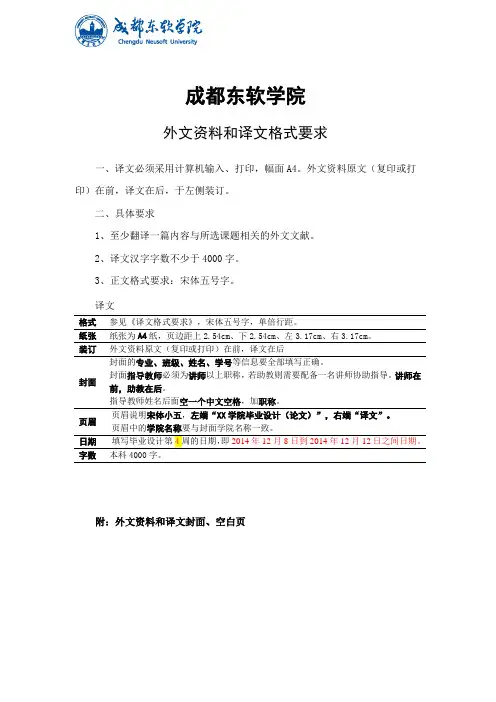
成都东软学院外文资料和译文格式要求一、译文必须采用计算机输入、打印,幅面A4。
外文资料原文(复印或打印)在前,译文在后,于左侧装订。
二、具体要求1、至少翻译一篇内容与所选课题相关的外文文献。
2、译文汉字字数不少于4000字。
3、正文格式要求:宋体五号字。
译文格式参见《译文格式要求》,宋体五号字,单倍行距。
纸张纸张为A4纸,页边距上2.54cm、下2.54cm、左3.17cm、右3.17cm。
装订外文资料原文(复印或打印)在前,译文在后封面封面的专业、班级、姓名、学号等信息要全部填写正确。
封面指导教师必须为讲师以上职称,若助教则需要配备一名讲师协助指导。
讲师在前,助教在后。
指导教师姓名后面空一个中文空格,加职称。
页眉页眉说明宋体小五,左端“XX学院毕业设计(论文)”,右端“译文”。
页眉中的学院名称要与封面学院名称一致。
字数本科4000字。
附:外文资料和译文封面、空白页成都东软学院外文资料和译文专业:软件工程移动互联网应用开发班级:2班姓名:罗荣昆学号:12310420216指导教师:2015年 12月 8日Android page layoutUsing XML-Based LayoutsW hile it is technically possible to create and attach widgets to our activity purely through Java code, the way we did in Chapter 4, the more common approach is to use an XML-based layout file. Dynamic instantiation of widgets is reserved for more complicated scenarios, where the widgets are not known at compile-time (e g., populating a column of radio buttons based on data retrieved off the Internet).With that in mind, it’s time to break out the XML and learn how to lay out Android activities that way.What Is an XML-Based Layout?As the name suggests, an XML-based layout is a specification of widgets’ relationships to each other—and to their containers (more on this in Chapter 7)—encoded in XML format. Specifi cally, Android considers XML-based layouts to be resources, and as such layout files are stored in the res/layout directory inside your Android project.Each XML file contains a tree of elements specifying a layout of widgets and their containers that make up one view hierarchy. The attributes of the XML elements are properties, describing how a widget should look or how a container should behave. For example, if a Button element has an attribute value of android:textStyle = "bold", that means that the text appearing on the face of the button should be rendered in a boldface font style.Android’s SDK ships with a tool (aapt) which uses the layouts. This tool should be automatically invoked by your Android tool chain (e.g., Eclipse, Ant’s build.xml). Of particular importance to you as a developer is that aapt generates the R.java source file within your project, allowing you to access layouts and widgets within those layouts directly from your Java code. Why Use XML-Based Layouts?Most everything you do using XML layout files can be achieved through Java code. For example, you could use setTypeface() to have a button render its textin bold, instead of using a property in an XML layout. Since XML layouts are yet another file for you to keep track of, we need good reasons for using such files.Perhaps the biggest reason is to assist in the creation of tools for view definition, such as a GUI builder in an IDE like Eclipse or a dedicated Android GUI designer like DroidDraw1. Such GUI builders could, in principle, generate Java code instead of XML. The challenge is re-reading the UI definition to support edits—that is far simpler if the data is in a structured format like XML than in a programming language. Moreover, keeping generated XML definitions separated from hand-written Java code makes it less likely that somebody’s custom-crafted source will get clobbered by accident when the generated bits get re-generated. XML forms a nice middle ground between something that is easy for tool-writers to use and easy for programmers to work with by hand as needed.Also, XML as a GUI definition format is becoming more commonplace. Microsoft’s XAML2, Adobe’s Flex3, and Mozilla’s XUL4 all take a similar approach to that of Android: put layout details in an XML file and put programming smarts in source files (e.g., JavaScript for XUL). Many less-well-known GUI frameworks, such as ZK5, also use XML for view definition. While “following the herd” is not necessarily the best policy, it does have the advantage of helping to ease the transition into Android from any other XML-centered view description language. OK, So What Does It Look Like?Here is the Button from the previous chapter’s sample application, converted into an XMLlayout file, found in the Layouts/NowRedux sample project. This code sample along with all others in this chapter can be found in the Source Code area of .<?xml version="1.0" encoding="utf-8"?><Button xmlns:android="/apk/res/android"android:id="@+id/button"android:text=""android:layout_width="fill_parent"android:layout_height="fill_parent"/>The class name of the widget—Button—forms the name of the XML element. Since Button is an Android-supplied widget, we can just use the bare class name. If you create your own widgets as subclasses of android.view.View, you would need to provide a full package declara tion as well.The root element needs to declare the Android XML namespace:xmlns:android="/apk/res/android"All other elements will be children of the root and will inherit that namespace declaration.Because we want to reference this button from our Java code, we need to give it an identifier via the android:id attribute. We will cover this concept in greater detail later in this chapter.The remaining attributes are properties of this Button instance:• android:text indicates the initial text to be displayed on the button face (in this case, an empty string)• android:layout_width and android:layout_height tell Android to have the button’swidth and height fill the “parent”, in this case the entire screen—these attributes will be covered in greater detail in Chapter 7.Since this single widget is the only content in our activity, we only need this single element. Complex UIs will require a whole tree of elements, representing the widgets and containers that control their positioning. All the remaining chapters of this book will use the XML layout form whenever practical, so there are dozens of other examples of more complex layouts for you to peruse from Chapter 7 onward.What’s with the @ Signs?Many widgets and containers only need to appear in the XML layout file and do not need to be referenced in your Java code. For example, a static label (TextView) frequently only needs to be in the layout file to indicate where it should appear. These sorts of elements in the XML file do not need to have the android:id attribute to give them a name.Anything you do want to use in your Java source, though, needs an android:id.The convention is to use @+id/... as the id value, where the ... represents your locally unique name for the widget in question. In the XML layout example in the preceding section, @+id/button is the identifier for the Button widget.Android provides a few special android:id values, of the form @android:id/.... We will see some of these in various chapters of this book, such as Chapters 8 and 10.We Attach These to the Java How?Given that you have painstakingly set up the widgets and containers in an XML layout filenamed main.xml stored in res/layout, all you need is one statement in your activity’s onCreate() callback to use that layout:setContentView(yout.main);This is the same setContentView() we used earlier, passing it an instance of a View subclass (in that case, a Button). The Android-built view, constructed from our layout, is accessed from that code-generated R class. All of the layouts are accessible under yout, keyed by the base name of the layout file—main.xml results in yout.main.To access our identified widgets, use findViewById(), passing in the numeric identifier of the widget in question. That numeric identifier was generated by Android in the R class asR.id.something (where something is the specific widget you are seeking). Those widgets are simply subclasses of View, just like the Button instance we created in Chapter 4.The Rest of the StoryIn the original Now demo, the button’s face would show the current time, which would reflect when the button was last pushed (or when the activity was first shown, if the button had not yet been pushed).Most of that logic still works, even in this revised demo (NowRedux). However,rather than instantiating the Button in our activity’s onCreate() callback, we can reference the one from the XML layout:package youts;import android.app.Activity;import android.os.Bundle;import android.view.View;import android.widget.Button; import java.util.Date;public class NowRedux extends Activity implements View.OnClickListener { Button btn;@Overridepublic void onCreate(Bundle icicle) { super.onCreate(icicle);setContentView(yout.main);btn=(Button)findViewById(R.id.button);btn.setOnClickListener(this);upd ateTime();}public void onClick(View view) { updateTime();}private void updateTime() {btn.setText(new Date().toString()); }}The first difference is that rather than setting the content view to be a view we created in Java code, we set it to reference the XML layout (setContentView(yout.main)). The R.java source file will be updated when we rebuild this project to include a reference to our layout file (stored as main.xml in our project’s res/l ayout directory).The other difference is that we need to get our hands on our Button instance, for which we use the findViewById() call. Since we identified our button as @+id/button, we can reference the button’s identifier as R.id.button. Now, with the Button instance in hand, we can set the callback and set the label as needed.As you can see in Figure 5-1, the results look the same as with the originalNow demo.Figure 5-1. The NowRedux sample activity Employing Basic WidgetsE very GUI toolkit has some basic widgets: fields, labels, buttons, etc. Android’s toolkit is no different in scope, and the basic widgets will provide a good introduction as to how widgets work in Android activities.Assigning LabelsThe simplest widget is the label, referred to in Android as a TextView. Like in most GUI toolkits, labels are bits of text not editable directly by users. Typically, they are used to identify adjacent widgets (e.g., a “Name:” label before a field where one fills in a name).In Java, you can create a label by creating a TextView instance. More commonly, though, you will create labels in XML layout files by adding a TextView element to the layout, with an android:text property to set the value of the label itself. If you need to swap labels based on certain criteria, such as internationalization, you may wish to use a resource reference in the XML instead, as will be described in Chapter 9. TextView has numerous other properties of relevance for labels, such as:• android:typeface to set the typeface to use for the label (e.g., monospace) • android:textStyle to indicate that the typeface should be made bold (bold), italic (italic),or bold and italic (bold_italic)• android:textColor to set the color of the label’s text, in RGB hex format (e.g., #FF0000 for red)For example, in the Basic/Label project, you will find the following layout file:<?xml version="1.0" encoding="utf-8"?><TextView xmlns:android=/apk/res/androidandroid:layout_width="fill_parent"android:layout_height="wrap_content"android:text="You were expecting something profound?" />As you can see in Figure 6-1, just that layout alone, with the stub Java source provided by Android’s p roject builder (e.g., activityCreator), gives you the application.Figure 6-1. The LabelDemo sample applicationButton, Button, Who’s Got the Button?We’ve already seen the use of the Button widget in Chapters 4 and 5. As it turns out, Button is a subclass of TextView, so everything discussed in the preceding section in terms of formatting the face of the button still holds. Fleeting ImagesAndroid has two widgets to help you embed images in your activities: ImageView and ImageButton. As the names suggest, they are image-based analogues to TextView and Button, respectively.Each widget takes an android:src attribute (in an XML layout) to specify what picture to use. These usually reference a drawable resource, described in greater detail in the chapter on resources. You can also set the image content based on a Uri from a content provider via setImageURI().ImageButton, a subclass of ImageView, mixes in the standard Button behaviors, for responding to clicks and whatnot.For example, take a peek at the main.xml layout from the Basic/ImageView sample project which is found along with all other code samples at : <?xml version="1.0" encoding="utf-8"?><ImageView xmlns:android=/apk/res/androidandroid:id="@+id/icon"android:layout_width="fill_parent"android:layout_height="fill_parent"android:adjustViewBounds="true"android:src="@drawable/molecule" />The result, just using the code-generated activity, is shown in Figure 6-2.Figure 6-2. The ImageViewDemo sample applicationFields of Green. Or Other Colors.Along with buttons and labels, fields are the third “anchor” of most GUI toolkits. In Android, they are implemented via the EditText widget, which is a subclass of the TextView used for labels.Along with the standard TextView properties (e.g., android:textStyle), EditText has many others that will be useful for you in constructing fields, including:• android:autoText, to control if the fie ld should provide automatic spelling assistance• android:capitalize, to control if the field should automatically capitalize the first letter of entered text (e.g., first name, city) • android:digits, to configure the field to accept only certain digi ts • android:singleLine, to control if the field is for single-line input or multiple-line input (e.g., does <Enter> move you to the next widget or add a newline?)Beyond those, you can configure fields to use specialized input methods, such asandroid:numeric for numeric-only input, android:password for shrouded password input,and android:phoneNumber for entering in phone numbers. If you want to create your own input method scheme (e.g., postal codes, Social Security numbers), you need to create your own implementation of the InputMethod interface, then configure the field to use it via android: inputMethod.For example, from the Basic/Field project, here is an XML layout file showing an EditText:<?xml version="1.0" encoding="utf-8"?><EditTextxmlns:android=/apk/res/androidandroid:id="@+id/field"android:layout_width="fill_parent"android:layout_height="fill_parent"android:singleLine="false" />Note that android:singleLine is false, so users will be able to enter in several lines of text. For this project, the FieldDemo.java file populates the input field with some prose:package monsware.android.basic;import android.app.Activity;import android.os.Bundle;import android.widget.EditText;public class FieldDemo extends Activity { @Overridepublic void onCreate(Bundle icicle) { super.onCreate(icicle);setContentView(yout.main);EditText fld=(EditText)findViewById(R.id.field);fld.setText("Licensed under the Apache License, Version 2.0 " + "(the \"License\"); you may not use this file " + "except in compliance with the License. You may " + "obtain a copy of the License at " +"/licenses/LICENSE-2.0");}}The result, once built and installed into the emulator, is shown in Figure 6-3.Figure 6-3. The FieldDemo sample applicationNote Android’s emulator only allows one application in the launcher per unique Java package. Since all the demos in this chapter share the monsware.android.basic package, you will only see one of these demos in your emulator’s launcher at any one time.Another flavor of field is one that offers auto-completion, to help users supply a value without typing in the whole text. That is provided in Android as the AutoCompleteTextView widget and is discussed in Chapter 8.Just Another Box to CheckThe classic checkbox has two states: checked and unchecked. Clicking the checkbox toggles between those states to indicate a choice (e.g., “Ad d rush delivery to my order”). In Android, there is a CheckBox widget to meet this need. It has TextView as an ancestor, so you can use TextView properties likeandroid:textColor to format the widget. Within Java, you can invoke: • isChecked() to determi ne if the checkbox has been checked• setChecked() to force the checkbox into a checked or unchecked state • toggle() to toggle the checkbox as if the user checked itAlso, you can register a listener object (in this case, an instance of OnCheckedChangeListener) to be notified when the state of the checkbox changes.For example, from the Basic/CheckBox project, here is a simple checkbox layout:<?xml version="1.0" encoding="utf-8"?><CheckBox xmlns:android="/apk/res/android"android:id="@+id/check"android:layout_width="wrap_content"android:layout_height="wrap_content"android:text="This checkbox is: unchecked" />The corresponding CheckBoxDemo.java retrieves and configures the behavior of the checkbox:public class CheckBoxDemo extends Activityimplements CompoundButton.OnCheckedChangeListener { CheckBox cb;@Overridepublic void onCreate(Bundle icicle) { super.onCreate(icicle);setContentView(yout.main);cb=(CheckBox)findViewById(R.id.check);cb.setOnCheckedChangeListener(this);}public void onCheckedChanged(CompoundButton buttonView,boolean isChecked) {if (isChecked) {cb.setText("This checkbox is: checked");}else {cb.setText("This checkbox is: unchecked");}}}Note that the activity serves as its own listener for checkbox state changes since it imple ments the OnCheckedChangeListener interface (via cb.setOnCheckedChangeListener(this)). The callback for the listener is onCheckedChanged(), which receives the checkbox whose state has changed and what the new state is. In this case, we update the text of the checkbox to reflect what the actual box contains.The result? Clicking the checkbox immediately updates its text, as you can see in Figures 6-4 and 6-5.Figure 6-4. The CheckBoxDemo sample application, with the checkbox uncheckedFigure 6-5. The same application, now with the checkbox checkedTurn the Radio UpAs with other implementations of radio buttons in other toolkits, Android’s radio buttons are two-state, like checkboxes, but can be grouped such that only one radio button in the group can be checked at any time.Like CheckBox, RadioButton inherits from CompoundButton, which in turn inherits fromTextView. Hence, all the standard TextView properties for font face, style, color, etc., are available for controlling the look of radio buttons. Similarly, you can call isChecked() on a RadioButton to see if it is selected, toggle() to select it, and so on, like you can with a CheckBox.Most times, you will want to put your RadioButton widgets inside of aRadioGroup. The RadioGroup indicates a set of radio buttons whose state is tied, meaning only one button out of the group can be selected at any time. If you assign an android:id to your RadioGroup in your XML layout, you can access the group from your Java code and invoke:• check() to check a specific radio button via its ID (e.g., group.check(R.id.radio1))• clearCheck() to clear all radio buttons, so none in the group are checked• getCheckedRadioButtonId() to get the ID of the currently-checked radio button (or -1 if none are checked)For example, from the Basic/RadioButton sample application, here is an XML layout showing a RadioGroup wrapping a set of RadioButton widgets: <?xml version="1.0" encoding="utf-8"?> <RadioGroupxmlns:android=/apk/res/androidandroid:orientation="vertical"android:layout_width="fill_parent"android:layout_height="fill_parent" ><RadioButton android:id="@+id/radio1"android:layout_width="wrap_content"android:layout_height="wrap_content"android:text="Rock" /><RadioButton android:id="@+id/radio2"android:layout_width="wrap_content"android:layout_height="wrap_content"android:text="Scissors" /><RadioButton android:id="@+id/radio3"android:layout_width="wrap_content"android:layout_height="wrap_content"android:text="Paper" /></RadioGroup>Figure 6-6 shows the result using the stock Android-generated Java forthe project and this layout.Figure 6-6. The RadioButtonDemo sample application Note that the radio button group is initially set to be completely unchecked at the outset. To pre-set one of the radio buttons to be checked, use either setChecked() on the RadioButton or check() on the RadioGroup from within your onCreate() callback in your activity.It’s Quite a ViewAll widgets, including the ones previously shown, extend View, and as such give all widgets an array of useful properties and methods beyond those already described.Useful PropertiesSome of the properties on View most likely to be used include:• Controls the focus sequence:• android:nextFocusDown• android:nextFocusLeft• android:nextFocusRight• android:nextFocusUp• android:visibility, which controls wheth er the widget is initially visible• android:background, which typically provides an RGB color value (e.g., #00FF00 for green) to serve as the background for the widgetUseful MethodsYou can toggle whether or not a widget is enabled via setEnabled() and see if it is enabled via isEnabled(). One common use pattern for this is to disable some widgets based on a CheckBox or RadioButton selection.You can give a widget focus via requestFocus() and see if it is focused via isFocused(). You might use this in concert with disabling widgets as previously mentioned, to ensure the proper widget has the focus once your disabling operation is complete.To help navigate the tree of widgets and containers that make up an activity’s overall view, you can use:• get Parent() to find the parent widget or container• findViewById() to find a child widget with a certain ID• getRootView() to get the root of the tree (e.g., what you provided to the activity via setContentView())Android 页面布局使用XML进行布局虽然纯粹通过Java代码在activity上创建和添加部件,在技术上是可行的,我们在第4章中做的一样,更常见的方法是使用一种基于XML的布局文件。
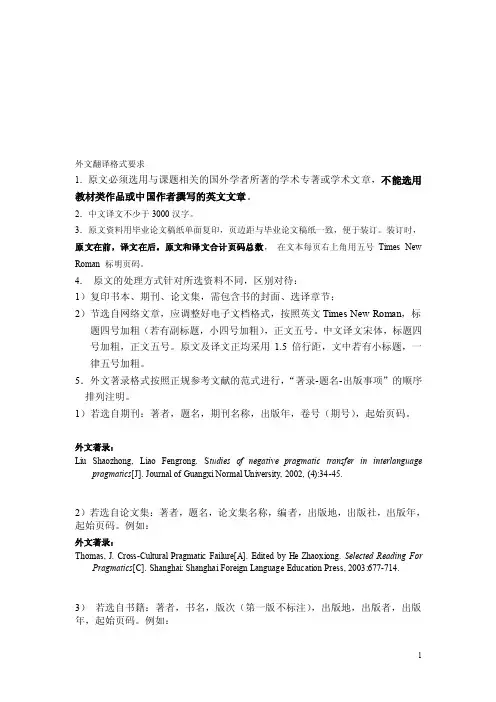
外文翻译格式要求1.原文必须选用与课题相关的国外学者所著的学术专著或学术文章,不能选用教材类作品或中国作者撰写的英文文章。
2.中文译文不少于3000汉字。
3.原文资料用毕业论文稿纸单面复印,页边距与毕业论文稿纸一致,便于装订。
装订时,原文在前,译文在后。
原文和译文合计页码总数,在文本每页右上角用五号Times New Roman 标明页码。
4.原文的处理方式针对所选资料不同,区别对待:1)复印书本、期刊、论文集,需包含书的封面、选译章节;2)节选自网络文章,应调整好电子文档格式,按照英文Times New Roman,标题四号加粗(若有副标题,小四号加粗),正文五号。
中文译文宋体,标题四号加粗,正文五号。
原文及译文正均采用1.5倍行距,文中若有小标题,一律五号加粗。
5.外文著录格式按照正规参考文献的范式进行,“著录-题名-出版事项”的顺序排列注明。
1)若选自期刊:著者,题名,期刊名称,出版年,卷号(期号),起始页码。
外文著录:Liu Shaozhong, Liao Fengrong. S tudies of negative pragmatic transfer in interlanguage pragmatics[J]. Journal of Guangxi Normal University, 2002, (4):34-45.2)若选自论文集:著者,题名,论文集名称,编者,出版地,出版社,出版年,起始页码。
例如:外文著录:Thomas, J. Cross-Cultural Pragmatic Failure[A]. Edited by He Zhaoxiong. Selected Reading For Pragmatics[C]. Shanghai: Shanghai Foreign Language Education Press, 2003:677-714.3)若选自书籍:著者,书名,版次(第一版不标注),出版地,出版者,出版年,起始页码。
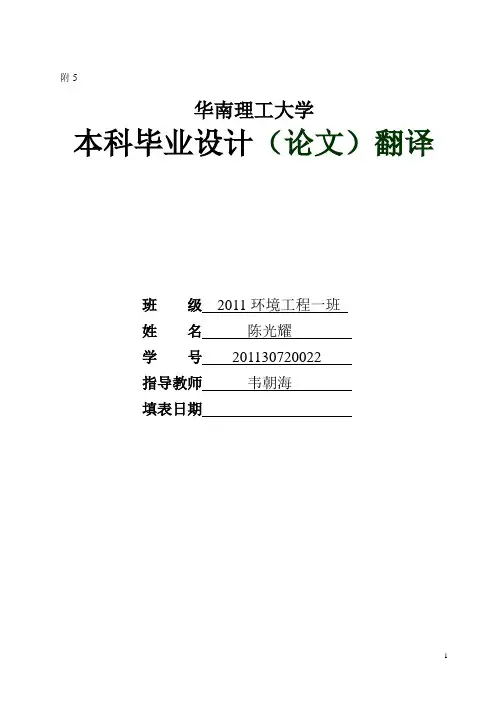
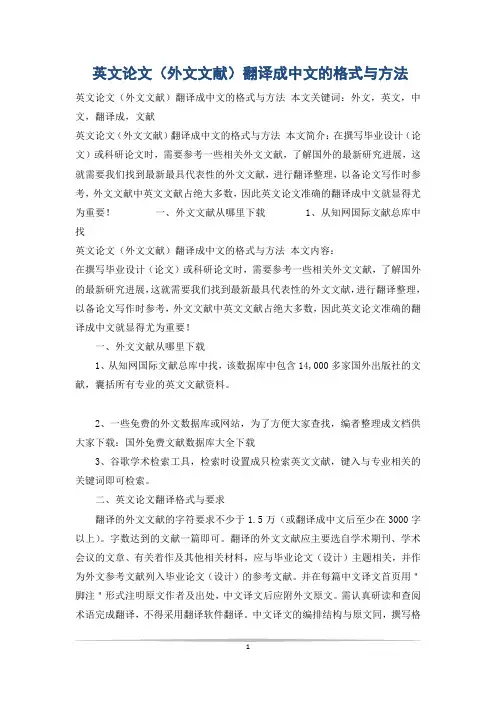
英文论文(外文文献)翻译成中文的格式与方法英文论文(外文文献)翻译成中文的格式与方法本文关键词:外文,英文,中文,翻译成,文献英文论文(外文文献)翻译成中文的格式与方法本文简介:在撰写毕业设计(论文)或科研论文时,需要参考一些相关外文文献,了解国外的最新研究进展,这就需要我们找到最新最具代表性的外文文献,进行翻译整理,以备论文写作时参考,外文文献中英文文献占绝大多数,因此英文论文准确的翻译成中文就显得尤为重要!一、外文文献从哪里下载1、从知网国际文献总库中找英文论文(外文文献)翻译成中文的格式与方法本文内容:在撰写毕业设计(论文)或科研论文时,需要参考一些相关外文文献,了解国外的最新研究进展,这就需要我们找到最新最具代表性的外文文献,进行翻译整理,以备论文写作时参考,外文文献中英文文献占绝大多数,因此英文论文准确的翻译成中文就显得尤为重要!一、外文文献从哪里下载1、从知网国际文献总库中找,该数据库中包含14,000多家国外出版社的文献,囊括所有专业的英文文献资料。
2、一些免费的外文数据库或网站,为了方便大家查找,编者整理成文档供大家下载:国外免费文献数据库大全下载3、谷歌学术检索工具,检索时设置成只检索英文文献,键入与专业相关的关键词即可检索。
二、英文论文翻译格式与要求翻译的外文文献的字符要求不少于1.5万(或翻译成中文后至少在3000字以上)。
字数达到的文献一篇即可。
翻译的外文文献应主要选自学术期刊、学术会议的文章、有关着作及其他相关材料,应与毕业论文(设计)主题相关,并作为外文参考文献列入毕业论文(设计)的参考文献。
并在每篇中文译文首页用"脚注"形式注明原文作者及出处,中文译文后应附外文原文。
需认真研读和查阅术语完成翻译,不得采用翻译软件翻译。
中文译文的编排结构与原文同,撰写格式参照毕业论文的格式要求。
参考文献不必翻译,直接使用原文的(字体,字号,标点符号等与毕业论文中的参考文献要求同),参考文献的序号应标注在译文中相应的地方。
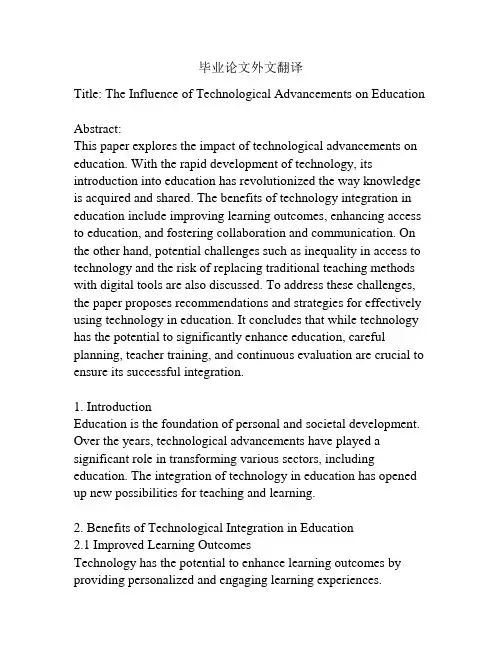
毕业论文外文翻译Title: The Influence of Technological Advancements on Education Abstract:This paper explores the impact of technological advancements on education. With the rapid development of technology, its introduction into education has revolutionized the way knowledge is acquired and shared. The benefits of technology integration in education include improving learning outcomes, enhancing access to education, and fostering collaboration and communication. On the other hand, potential challenges such as inequality in access to technology and the risk of replacing traditional teaching methods with digital tools are also discussed. To address these challenges, the paper proposes recommendations and strategies for effectively using technology in education. It concludes that while technology has the potential to significantly enhance education, careful planning, teacher training, and continuous evaluation are crucial to ensure its successful integration.1. IntroductionEducation is the foundation of personal and societal development. Over the years, technological advancements have played a significant role in transforming various sectors, including education. The integration of technology in education has opened up new possibilities for teaching and learning.2. Benefits of Technological Integration in Education2.1 Improved Learning OutcomesTechnology has the potential to enhance learning outcomes by providing personalized and engaging learning experiences.Interactive multimedia resources, such as videos, simulations, and virtual reality, can make complex concepts more accessible and understandable for students. Additionally, learning management systems and online platforms enable students to access educational materials anytime and anywhere, facilitating self-paced learning. 2.2 Enhanced Access to EducationTechnology has greatly expanded access to education, especially in remote and underserved areas. Online courses, virtual classrooms, and open educational resources have democratized education, allowing individuals to overcome geographical barriers and access learning opportunities that were previously unavailable. Furthermore, technology has created opportunities for lifelong learning, making education more accessible to adults and professionals.2.3 Collaboration and CommunicationTechnology enables collaboration and communication among students, teachers, and experts from different locations. Online discussion forums, video conferencing, and collaborative tools promote active participation, peer learning, and knowledge sharing. These digital platforms also facilitate communication between teachers and students, providing instant feedback and support outside of the traditional classroom settings.3. Challenges and ConcernsDespite the numerous benefits, there are challenges and concerns associated with technology integration in education.3.1 Inequality in Access to TechnologyThe digital divide creates unequal access to technology, making it difficult for some students to fully benefit from technology in their educational journey. Limited access to devices, stable internet connection, and technology literacy are major barriers that need to be addressed to ensure equal opportunities for all learners.3.2 Potential Over-reliance on TechnologyThere is a risk of over-reliance on technology, leading to the exclusion of effective traditional teaching methods or neglecting essential skills, such as critical thinking and problem-solving. It is important to strike a balance between technology use and traditional teaching approaches, ensuring that technology complements and enhances, rather than replaces, the core aspects of education.4. Recommendations and StrategiesTo harness the potential of technology in education, it is important to consider the following recommendations and strategies:4.1 Infrastructure and AccessEfforts should be made to bridge the digital divide by providing infrastructure, such as devices and internet connectivity, to underserved communities. Schools and educational institutions should prioritize equal access to technology and ensure that students have the necessary skills to utilize it effectively.4.2 Teacher Training and Professional DevelopmentTeachers play a critical role in integrating technology into the curriculum. Adequate training and professional development programs are essential to equip teachers with the skills andknowledge to effectively use technology for teaching and learning purposes. Continuous support and opportunities for collaboration and sharing of best practices should be provided.4.3 Continuous Evaluation and AdaptationRegular evaluation and feedback mechanisms should be in place to assess the impact of technology integration on learning outcomes. This will help identify areas for improvement and adapt teaching practices accordingly. Continuous evaluation will also ensure that the integration of technology remains aligned with educational goals and objectives.5. ConclusionTechnology has the potential to reshape education in unprecedented ways. This paper has highlighted the benefits and challenges of technology integration in education. It is essential to recognize that technology is a tool, not a substitute for quality teaching and learning. Strategic planning, teacher training, and evaluation are necessary to ensure technology's effective integration into education, thus harnessing its full potential to improve learning outcomes, enhance access to education, and foster collaboration and communication.。
盐城师范学院毕业论文(设计)外文资料翻译学院:(四号楷体_GB2312下同)专业班级:学生姓名:学号:指导教师:外文出处:(外文)(Times New Roman四号) 附件:1.外文资料翻译译文; 2.外文原文1.外文资料翻译译文译文文章标题×××××××××正文×××××××××××××××××××××××××××××××××××××××××××××××××××××××××××××××××…………。
*注:(本注释不是外文翻译的部分,只是本式样的说明解释)1. 译文文章标题为三号黑体居中,缩放、间距、位置标准,无首行缩进,无左右缩进,且前空(四号)两行,段前、段后各0.5行间距,行间距为1.25倍多倍行距;2. 正文中标题为小四号,中文用黑体,英文用Times New Roman体,缩放、间距、位置标准,无左右缩进,无首行缩进,无悬挂式缩进,段前、段后0.5行间距,行间距为1.25倍多倍行距;3. 正文在文章标题下空一行,为小四号,中文用宋体,英文用Times New Roman体,缩放、间距、位置标准,无左右缩进,首行缩进2字符(两个汉字),无悬挂式缩进,段前、段后间距无,行间距为1.25倍多倍行距;4. 强行分页时请用插入分页符换页;5. 正文中表格与插图的字体,中文部分一律用五号楷体_GB2312;表格用三线表。
附件一:英文文献INTRODUCTIONOffences of strict liability are those crimes which do not require mens rea with regard to at least one or more elements of the actus reus. The defendant need not have intended or known about that circumstance or consequence. Liability is said to be strict with regard to that element. For a good example see:R v Prince[1875]:The defendant ran off with an under-age girl. He was charged with an offence of taking a girl under the age of 16 out of the possession of her parents contrary to s55 of the Offences Against the Person Act 1861. The defendant knew that the girl was in the custody her father but he believed on reasonable grounds that the girl was aged 18. It was held that knowledge that the girl was under the age of 16 was not required in order to establish the offence. It was sufficient to show that the defendant intended to take the girl out of the possession of her father.It is only in extreme and rare cases where no mens rea is required for liability, thereby making the particular offence "absolute".GENERAL PRINCIPLESThe vast majority of strict liability crimes are statutory offences. However, statutes do not state explicitly that a particular offence is one of strict liability. Where a statute uses terms such as "knowingly" or "recklessly" then the offence being created is one that requires mens rea. Alternatively, it may make it clear that an offence of strict liability is being created. In many cases it will be a matter for the courts to interpret the statute and decide whether mens rea is required or not. What factors are taken into account by the courts when assessing whether or not an offence falls into the category of strict liability offences?THE MODERN CRITERIAIn Gammon (Hong Kong) Ltd v Attorney-General for Hong Kong [1984], the Privy Council considered the scope and role of strict liability offences in the modern criminal law and their effect upon the "presumption of mens rea". Lord Scarman laid down the criteria upon which a court should decide whether or not it is appropriate to impose strict liability: "In their Lordships' opinion, the law … may be stated in the following propositions … : (1) there is a presumption of law that mens rea is required before a person can be held guilty of a criminal offence; (2) the presumption is particularly strong where the offence is "truly criminal" in character; (3) the presumption applies to statutory offences, and can be displaced only if this is clearly or by necessary implication the effect of the statute; (4) the only situation in which the presumption can be displaced is where the statute is concerned with an issue of social concern, and public safety is such an issue; (5) even where a statute is concerned with such an issue, the presumption of mens rea stands unless it can be shown that the creation of strict liability will be effective to promote the objects of the statute by encouraging greater vigilance to prevent the commission of the prohibited act."(1) PRESUMPTION OF MENS REACourts usually begin with the presumption in favor of mens rea, seeing the well-known statement by Wright J in Sherras v De Rutzen:There is a presumption that mens rea, or evil intention, or knowledge of the wrongfulness of the act, is an essential ingredient in every offence; but that presumption is liable to be displaced either by the words of the statute creating the offence or by the subject-matter with which it deals, and both must be considered(2) GRAVITY OF PUNISHMENTAs a general rule, the more serious the criminal offence created by statute, the less likely the courts is to view it as an offence of strict liability. See:Sweet v Parsley [1970]:The defendant was a landlady of a house let to tenants. She retained one room in the house for herself and visited occasionally to collect the rent and letters. While she was absent the police searched the house and found cannabis. The defendant was convicted under s5 of the Dangerous Drugs Act 1965, of "being concerned in the management of premises used for the smoking of cannabis". She appealed alleging that she had no knowledge of the circumstances and indeed could not expect reasonably to have had such knowledge.The House of Lords,quashing her conviction, held that it had to be proved that the defendant had intended the house to be used for drug-taking, since the statute in question created a serious, or "truly criminal" offence, conviction for which would have grave consequences for the defendant. Lord Reid stated that "a stigma still attaches to any person convicted of a truly criminal offence, and the more serious or more disgraceful the offence the greater the stigma". And equally important, "the press in this country are vigilant to expose injustice, and every manifestly unjust conviction made known to the public tends to injure the body politic [people of a nation] by undermining public confidence in the justice of the law and of its administration."Lord Reid went on to point out that in any event it was impractical to impose absolute liability for an offence of this nature, as those who were responsible for letting properties could not possibly be expected to know everything that their tenants were doing.(3) WORDING OF THE STATUTEIn determining whether the presumption in favor of mens rea is to be displaced, the courts are required to have reference to the whole statute in which the offence appears. See:Cundy v Le Cocq (1884) :The defendant was convicted of unlawfully selling alcohol to an intoxicated person, contrary to s13 of the Licensing Act 1872. On appeal, the defendant contended that he had been unaware of the customer's drunkenness and thus should be acquitted. The Divisional Court interpreted s13 as creating an offence of strict liability since it was itself silent as to mens rea, whereas other offences under the same Act expressly required proof of knowledge on the part of the defendant. It was held that it was not necessary to consider whether the defendant knew, or had means of knowing, or could with ordinary care have detected that the person served was drunk. If he served a drink to a person who was in fact drunk, he was guilty. Stephen J stated: Here, as I have already pointed out, the object of this part of the Act is to prevent the sale of intoxicating liquor to drunken persons, and it is perfectly natural to carry that out by throwing on the publican the responsibility of determining whether the person supplied comes within that category.(4) ISSUES OF SOCIAL CONCERNSee :R v Blake (1996) :Investigation officers heard an unlicensed radio station broadcast and traced it to a flat where the defendant was discovered alone standing in front of the record decks, still playing music and wearing a set of headphones. Though the defendant admitted that he knewhe was using the equipment, he claimed that he believed he was making demonstration tapes and did not know he was transmitting. The defendant was convicted of using wireless telegraphy equipment without a license, contrary to s1 (1) Wireless Telegraphy Act 1949 and appealed on the basis that the offence required mens rea.The Court of Appeal held that the offence was an absolute (actually a strict) liability offence. The Court applied Lord Scarman's principles in Gammon and found that, though the presumption in favor of mens rea was strong because the offence carried a sentence of imprisonment and was, therefore, "truly criminal", yet the offence dealt with issues of serious social concern in the interests of public safety (namely, frequent unlicensed broadcasts on frequencies used by emergency services) and the imposition of strict liability encouraged greater vigilance in setting up careful checks to avoid committing the offence.(5) IS THERE ANY PURPOSE IN IMPOSING STRICT LIABILITY?The courts will be reluctant to construe a statute as imposing strict liability upon a defendant, where there is evidence to suggest that despite his having taken all reasonable steps, he cannot avoid the commission of an offence. See:Sherras v De Rutzen [1895]: The defendant was convicted of selling alcohol to a police officer whilst on duty, contrary to s16(2) of the Licensing Act 1872. He had reasonably believed the constable to be off duty as he had removed his arm-band, which was the acknowledged method of signifying off duty. The Divisional Court held that the conviction should be quashed, despite the absence from s16 (2) of any words requiring proof of mens rea as an element of the offence. Wright J expressed the view that the presumption in favor of mens rea would only be displaced by the wording of the statute itself, or its subject matter. In this case the latter factor was significant, in that no amount of reasonable care by the defendant would have prevented the offence from being committed. Wright J stated: "It is plain that if guilty knowledge is not necessary, no care on the part of the publican could save him from a conviction under section 16, subsection (2), since it would be as easy for the constable to deny that he was on duty when asked, or to produce a forged permission from his superior officer, as to remove his armlet before entering the public house. I am, therefore, of opinion that this conviction ought to be quashed."MODERN EXAMPLESThe following case is a modern example of the imposition of strict liability: Alphacell v Woodward [1972] The defendants were charged with causing polluted matter to enter a river contrary to s2 of the Rivers (Prevention of Pollution) Act 1951. The river had in fact been polluted because a pipe connected to the defendant's factory had been blocked, and the defendants had not been negligent. The House of Lords nevertheless held that the defendants were liable. Lord Salmon stated: If this appeal succeeded and it were held to be the law that no conviction be obtained under the 1951 Act unless the prosecution could discharge the often impossible onus of proving that the pollution was caused intentionally or negligently, a great deal of pollution would go unpunished and undeterred to the relief of many riparian factory owners. As a result, many rivers which are now filthy would become filthier still and many rivers which are now clean would lose their cleanliness. The legislature no doubt recognized that as a matter of public policy this would be most unfortunate. Hence s2(1)(a) which encourages riparian factory owners not only to take reasonable steps to prevent pollution but to do everything possible to ensure that they do not cause it.ARGUMENTS FOR STRICT LIABILITY1. The primary function of the courts is the prevention of forbidden acts. What acts should be regarded as forbidden? Surely only such acts as we can assert ought not to have been done. Some of the judges who upheld the conviction of Prince did so on the ground that men should be deterred from taking girls out of the possession of their parents, whatever the girl's age. This reasoning can hardly be applied to many modern offences of strict liability. We do not wish to deter people from driving cars, being concerned in the management of premises, financing hire purchase transactions or canning peas. These acts, if done with all proper care, are not such acts as the law should seek to prevent.2. Another argument that is frequently advanced in favor of strict liability is that, without it, many guilty people would escape - that there is neither time nor personnel available to litigate the culpability of each particular infraction. T his argument assumes that it is possible to deal with these cases without deciding whether D had mens rea or not, whether he was negligent or not. Certainly D may be convicted without deciding these questions, but how can he be sentenced? Suppose that a butcher sells some meat which is unfit for human consumption. Clearly the court will deal differently with (i) the butcher who knew that the meat was tainted; (ii) the butcher who did not know, but ought to have known; and (iii) the butcher who did not know and had no means of finding out. Sentence can hardly be imposed without deciding into which category the convicted person falls.3. The argument which is probably most frequently advanced by the courts for imposing strict liability is that it is necessary to do so in the interests of the public. Now it may be conceded that in many of the instances where strict liability has been imposed, the public does need protection against negligence and, assuming that the threat of punishment can make the potential harm doer more careful, there may be a valid ground for imposing liability for negligence as well as where there is mens rea. This is a plausible argument in favor of strict liability if there were no middle way between mens rea and strict liability - that is liability for negligence - and the judges have generally proceeded on the basis that there is no such middle way. Liability for negligence has rarely been spelled out of a statute except where, as in driving without due care, it is explicitly required. Lord Devlin has said: "It is not easy to find a way of construing a statute apparently expressed in terms of absolute liability so as to produce the requirement of negligence."ARGUMENTS AGAINST STRICT LIABILITY1. The case against strict liability, then, is, first, that it is unnecessary. It results in the conviction of persons who have behaved impeccably and who should not be required to alter their conduct in any way.2. Secondly, that it is unjust. Even if an absolute discharge can be given D may feel rightly aggrieved at having been formally convicted of an offence for which he bore no responsibility. Moreover, a conviction may have far-reaching consequences outside the courts, so that it is no answer to say that only a nominal penalty is imposed.3. The imposition of liability for negligence would in fact meet the arguments of most of those who favor strict liability. Such statutes are not meant to punish the vicious will but to put pressure upon the thoughtless and inefficient to do their whole duty in the interest of public health or safety or morals." The "thoughtless and inefficient" are, of course, the negligent. The objection tooffences of strict liability is not that these persons are penalized, but that others who are completely innocent are also liable to conviction. Though Lord Devlin was skeptical about the possibility of introducing the criterion of negligence (above), in Reynolds v Austin (1951) he stated that strict liability should only apply when there is something that the defendant can do to promote the observance of the law - which comes close to requiring negligence. If there were something which D could do to prevent the commission of the crime and which he failed to do, he might generally be said to have failed to comply with a duty - perhaps a high duty - of care; and so have been negligent.4. In Alphacell v Woodward (1972) Lord Salmon thought the relevant statutory section, "encourages riparian factory owners not only to take reasonable steps to prevent pollution but to do everything possible to ensure that they do not cause it." This suggests that, however vast the expenditure involved, and however unreasonable it may be in relation to the risk, D is under a duty to take all possible steps. Yet it may be doubted whether factory owners will in fact do more than is reasonable; and it is questionable whether they ought to be required to do so, at the risk - even though it be unlikely - of imprisonment. The contrary argument is that the existence of strict liability does induce organizations to aim at higher and higher standards.POSSIBLE DEVELOPMENTSThere are several possible compromises between mens rea and strict liability in regulatory offences. A "halfway house" has developed in Australia. The effect of Australian cases is: D might be convicted without proof of any mens rea by the Crown; but acquitted if he proved on a balance of probabilities that he lacked mens rea and was not negligent; ie, that he had an honest and reasonable belief in a state of facts which, would have made his act innocent. The onus of proving reasonable mistake is on D.STATUTORY DEFENCESIt is common for the drastic effect of a statute imposing strict liability to be mitigated by the provision of a statutory defense. It is instructive to consider one example. Various offences relating to the treatment and sale of food are enacted by the first twenty sections of the Food Safety Act 1990. Many, if not all, of these are strict liability offences. Section 21(1), however, provides that it shall be a defense for the person charged with any of the offences to prove that he took all reasonable precautions and exercised all due diligence to avoid the commission of the offence by himself or by a person under his control. Statutory defenses usually impose on the defendant a burden of proving that he had no mens rea and that he took all reasonable precautions and exercised all due diligence to avoid the commission of an offence. The effect of such provisions is that the prosecution need do no more than prove that the accused did the prohibited act and it is then for him to establish, if he can, that he did it innocently. Such provisions are a distinct advance on unmitigated strict liability.附件二:英文文献翻译介绍严格责任犯罪是关于客观方面的一个或多个因素不要求犯罪意图的那些犯罪。
嘉兴学院毕业论文(设计)外文翻译撰写格式规范一、外文翻译形式要求1、要求本科生毕业论文(设计)外文翻译部分的外文字符不少于1.5万字, 每篇外文文献翻译的中文字数要求达到2000字以上,一般以2000~3000字左右为宜。
2、翻译的外文文献应主要选自学术期刊、学术会议的文章、有关著作及其他相关材料,应与毕业论文(设计)主题相关,并作为外文参考文献列入毕业论文(设计)的参考文献。
3、外文翻译应包括外文文献原文和译文,译文要符合外文格式规范和翻译习惯。
二、打印格式嘉兴学院毕业论文(设计)外文翻译打印纸张统一用A4复印纸,页面设置:上:2.8;下:2.6;左:3.0;右:2.6;页眉:1.5;页脚:1.75。
段落格式为:1.5倍行距,段前、段后均为0磅。
页脚设置为:插入页码,居中。
具体格式见下页温馨提示:正式提交“嘉兴学院毕业论文(设计)外文翻译”时请删除本文本中说明性的文字部分(红字部分)。
嘉兴学院本科毕业论文(设计)外文翻译题目:(指毕业论文题目)学院名称:服装与艺术设计学院专业班级:楷体小四学生姓名:楷体小四一、外文原文见附件(文件名:12位学号+学生姓名+3外文原文.文件扩展名)。
二、翻译文章翻译文章题目(黑体小三号,1.5倍行距,居中)作者(用原文,不需翻译,Times New Roman五号,加粗,1.5倍行距,居中)工作单位(用原文,不需翻译,Times New Roman五号,1.5倍行距,居中)摘要:由于消费者的需求和汽车市场竞争力的提高,汽车检测标准越来越高。
现在车辆生产必须长于之前的时间并允许更高的价格进行连续转售……。
(内容采用宋体五号,1.5倍行距)关键词:汽车产业纺织品,测试,控制,标准,材料的耐用性1 导言(一级标题,黑体五号,1.5倍行距,顶格)缩进两个字符,文本主体内容采用宋体(五号),1.5倍行距参考文献(一级标题,黑体五号, 1.5倍行距,顶格)略(参考文献不需翻译,可省略)资料来源:AUTEX Research Journal, V ol. 5, No3, September 2008*****译****校(另起一页)三、指导教师评语***同学是否能按时完成外文翻译工作。
外文原文(一)Savigny and his Anglo-American Disciple s*M. H. HoeflichFriedrich Carl von Savigny, nobleman, law reformer, champion of the revived German professoriate, and founder of the Historical School of jurisprudence, not only helped to revolutionize the study of law and legal institutions in Germany and in other civil law countries, but also exercised a profound influence on many of the most creative jurists and legal scholars in England and the United States. Nevertheless, tracing the influence of an individual is always a difficult task. It is especially difficult as regards Savigny and the approach to law and legal sources propounded by the Historical School. This difficulty arises, in part, because Savigny was not alone in adopting this approach. Hugo, for instance, espoused quite similar ideas in Germany; George Long echoed many of these concepts in England during the 1850s, and, of course, Sir Henry Sumner Maine also espoused many of these same concepts central to historical jurisprudence in England in the 1860s and 1870s. Thus, when one looks at the doctrinal writings of British and American jurists and legal scholars in the period before 1875, it is often impossible to say with any certainty that a particular idea which sounds very much the sort of thing that might, indeed, have been derived from Savigny's works, was, in fact, so derived. It is possible, nevertheless, to trace much of the influence of Savigny and his legal writings in the United States and in Great Britain during this period with some certainty because so great was his fame and so great was the respect accorded to his published work that explicit references to him and to his work abound in the doctrinal writing of this period, as well as in actual law cases in the courts. Thus, Max Gutzwiller, in his classic study Der einfluss Savignys auf die Entwicklung des International privatrechts, was able to show how Savigny's ideas on conflict of laws influenced such English and American scholars as Story, Phillimore, Burge, and Dicey. Similarly, Andreas Schwarz, in his "Einflusse Deutscher Zivilistik im Auslande," briefly sketched Savigny's influence upon John Austin, Frederick Pollock, and James Bryce. In this article I wish to examine Savigny's influence over a broader spectrum and to draw a picture of his general fame and reputation both in Britain and in the United States as the leading Romanist, legal historian, and German legal academic of his day. The picture of this Anglo-American respect accorded to Savigny and the historical school of jurisprudence which emerges from these sources is fascinating. It sheds light not only upon Savigny’s trans-channel, trans-Atlantic fame, but also upon the extraordinarily*M.H.Hoeflich, Savigny and his Anglo-American Disciples, American Journal of Comparative Law, vol.37, No.1, 1989.cosmopolitan outlook of many of the leading American and English jurists of the time. Of course, when one sets out to trace the influence of a particular individual and his work, it is necessary to demonstrate, if possible, precisely how knowledge of the man and his work was transmitted. In the case of Savigny and his work on Roman law and ideas of historical jurisprudence, there were three principal modes of transmission. First, there was the direct influence he exercised through his contacts with American lawyers and scholars. Second, there was the influence he exercised through his books. Third, there was the influence he exerted indirectly through intermediate scholars and their works. Let us examine each mode separately.I.INFLUENCE OF THE TRANSLATED WORKSWhile American and British interest in German legal scholarship was high in the antebellum period, the number of American and English jurists who could read German fluently was relatively low. Even those who borrowed from the Germans, for instance, Joseph Story, most often had to depend upon translations. It is thus quite important that Savigny’s works were amongst the most frequently translated into English, both in the United States and in Great Britain. His most influential early work, the Vom Beruf unserer Zeitfur Rechtsgeschichte und Gestzgebung, was translated into English by Abraham Hayward and published in London in 1831. Two years earlier the first volume of his History of Roman Law in the Middle Ages was translated by Cathcart and published in Edinburgh. In 1830, as well, a French translation was published at Paris. Sir Erskine Perry's translation of Savigny's Treatise on Possession was published in London in 1848. This was followed by Archibald Brown's epitome of the treatise on possession in 1872 and Rattigan's translation of the second volume of the System as Jural Relations or the Law of Persons in 1884. Guthrie published a translation of the seventh volume of the System as Private International Law at Edinburgh in 1869. Indeed, two English translations were even published in the far flung corners of the British Raj. A translation of the first volume of the System was published by William Holloway at Madras in 1867 and the volume on possession was translated by Kelleher and published at Calcutta in 1888. Thus, the determined English-speaking scholar had ample access to Savigny's works throughout the nineteenth century.Equally important for the dissemination of Savigny's ideas were those books and articles published in English that explained and analyzed his works. A number of these must have played an important role in this process. One of the earliest of these is John Reddie's Historical Notices of the Roman law and of the Progress of its Study in Germany, published at Edinburgh in 1826. Reddie was a noted Scots jurist and held the Gottingen J.U.D. The book, significantly, is dedicated to Gustav Hugo. It is of that genre known as an external history of Roman law-not so much a history of substantive Roman legal doctrine but rather a historyof Roman legal institutions and of the study of Roman law from antiquity through the nineteenth century. It is very much a polemic for the study of Roman law and for the Historical School. It imparts to the reader the excitement of Savigny and his followers about the study of law historically and it is clear that no reader of the work could possibly be left unmoved. It is, in short, the first work of public relations in English on behalf of Savigny and his ideas.Having mentioned Reddie's promotion of Savigny and the Historical School, it is important to understand the level of excitement with which things Roman and especially Roman law were greeted during this period. Many of the finest American jurists were attracted-to use Peter Stein's term-to Roman and Civil law, but attracted in a way that, at times, seems to have been more enthusiastic than intellectual. Similarly, Roman and Civil law excited much interest in Great Britain, as illustrated by the distinctly Roman influence to be found in the work of John Austin. The attraction of Roman and Civil law can be illustrated and best understood, perhaps, in the context of the publicity and excitement in the English-speaking world surrounding the discovery of the only complete manuscript of the classical Roman jurist Gaius' Institutes in Italy in 1816 by the ancient historian and German consul at Rome, B.G. Niebuhr. Niebuhr, the greatest ancient historian of his time, turned to Savigny for help with the Gaius manuscript (indeed, it was Savigny who recognized the manuscript for what it was) and, almost immediately, the books and journals-not just law journals by any means-were filled with accounts of the discovery, its importance to legal historical studies, and, of course, what it said. For instance, the second volume of the American Jurist contains a long article on the civil law by the scholarly Boston lawyer and classicist, John Pickering. The first quarter of the article is a gushing account of the discovery and first publication of the Gaius manuscript and a paean to Niebuhr and Savigny for their role in this. Similarly, in an article published in the London Law Magazine in 1829 on the civil law, the author contemptuously refers to a certain professor who continued to tell his students that the text of Gaius' Institutes was lost for all time. What could better show his ignorance of all things legal and literary than to be unaware of Niebuhr's great discovery?Another example of this reaction to the discovery of the Gaius palimpsest is to be found in David Irving's Introduction to the Study of the Civil Law. This volume is also more a history of Roman legal scholarship and sources than a study of substantive Roman law. Its pages are filled with references to Savigny's Geschichte and its approach clearly reflects the influence of the Historical School. Indeed, Irving speaks of Savigny's work as "one of the most remarkable productions of the age." He must have been truly impressed with German scholarship and must also have been able to convince the Faculty of Advocates, forwhom he was librarian, of the worth of German scholarship, for in 1820 the Faculty sent him to Gottingen so that he might study their law libraries. Irving devotes several pages of his elementary textbook on Roman law to the praise of the "remarkable" discovery of the Gaius palimpsest. He traces the discovery of the text by Niebuhr and Savigny in language that would have befitted an adventure tale. He elaborates on the various labors required to produce a new edition of the text and was particularly impressed by the use of a then new chemical process to make the under text of the palimpsest visible. He speaks of the reception of the new text as being greeted with "ardor and exultation" strong words for those who spend their lives amidst the "musty tomes" of the Roman law.This excitement over the Verona Gaius is really rather strange. Much of the substance of the Gaius text was already known to legal historians and civil lawyers from its incorporation into Justinian's Institutes and so, from a substantive legal perspective, the find was not crucial. The Gaius did provide new information on Roman procedural rules and it did also provide additional information for those scholars attempting to reconstruct pre-Justinianic Roman law. Nevertheless, these contributions alone seem hardly able to justify the excitement the discovery caused. Instead, I think that the Verona Gaius discovery simply hit a chord in the literary and legal community much the same as did the discovery of the Rosetta Stone or of Schliemann’s Troy. Here was a monument of a great civilization brought newly to light and able to be read for the first time in millenia. And just as the Rosetta Stone helped to establish the modern discipline of Egyptology and Schliemann's discoveries assured the development of classical archaeology as a modern academic discipline, the discovery of the Verona Gaius added to the attraction Roman law held for scholars and for lawyers, even amongst those who were not Romanists by profession. Ancillary to this, the discovery and publication of the Gaius manuscript also added to the fame of the two principals involved in the discovery, Niebuhr and Savigny. What this meant in the English-speaking world is that even those who could not or did not wish to read Savigny's technical works knew of him as one of the discoverers of the Gaius text. This fame itself may well have helped in spreading Savigny's legal and philosophical ideas, for, I would suggest, the Gaius "connection" may well have disposed people to read other of Savigny's writings, unconnected to the Gaius, because they were already familiar with his name.Another example of an English-speaking promoter of Savigny is Luther Stearns Cushing, a noted Boston lawyer who lectured on Roman law at the Harvard Law School in 1848-49 and again in 1851- 1852.Cushing published his lectures at Boston in 1854 under the title An Introduction to the Study of Roman Law. He devoted a full chapter to a description of the historical school and to the controversy betweenSavigny and Thibaut over codification. While Cushing attempted to portray fairly the arguments of both sides, he left no doubt as to his preference for Savigny's approach:The labors of the historical school have established an entirely new and distinct era in the study of the Roman jurisprudence; and though these writers cannot be said to have thrown their predecessors into the shade, it seems to be generally admitted, that almost every branch of the Roman law has received some important modification at their hands, and that a knowledge of their writings, to some extent, at least, is essentially necessary to its acquisition.译文(一)萨维尼和他的英美信徒们*M·H·豪弗里奇弗雷德里奇·卡尔·冯·萨维尼出身贵族,是一位出色的法律改革家,也是一位倡导重建德国教授协会的拥护者,还是历史法学派的创建人之一。
本科毕业设计(论文)外文翻译译文学生姓名:院(系):油气资源学院专业班级:物探0502指导教师:完成日期:年月日地震驱动评价与发展:以玻利维亚冲积盆地的研究为例起止页码:1099——1108出版日期:NOVEMBER 2005THE LEADING EDGE出版单位:PanYAmericanYEnergyvBuenosYAiresvYArgentinaJPYBLANGYvYBPYExplorationvYHoustonvYUSAJ.C.YCORDOVAandYE.YMARTINEZvYChacoYS.A.vYSantaYCruzvYBolivia 通过整合多种地球物理地质技术,在玻利维亚冲积盆地,我们可以减少许多与白垩纪储集层勘探有关的地质技术风险。
通过对这些远景区进行成功钻探我们可以验证我们的解释。
这些方法包括盆地模拟,联井及地震叠前同时反演,岩石性质及地震属性解释,A VO/A V A,水平地震同相轴,光谱分解。
联合解释能够得到构造和沉积模式的微笑校正。
迄今为止,在新区有七口井已经进行了成功钻探。
基质和区域地质。
Tarija/Chaco盆地的subandean 褶皱和冲断带山麓的中部和南部,部分扩展到玻利维亚的Boomerange地区经历了集中的成功的开采。
许多深大的泥盆纪气田已经被发现,目前正在生产。
另外在山麓发现的规模较小较浅的天然气和凝析气田和大的油田进行价格竞争,如果他们能产出较快的油流而且成本低。
最近发现气田就是这种情况。
接下来,我们赋予Aguja的虚假名字就是为了讲述这些油田的成功例子。
图1 Aguja油田位于玻利维亚中部Chaco盆地的西北角。
基底构造图显示了Isarzama背斜的相对位置。
地层柱状图显示了主要的储集层和源岩。
该油田在Trija和冲积盆地附近的益背斜基底上,该背斜将油田和Ben i盆地分开(图1),圈闭类型是上盘背斜,它存在于连续冲断层上,Aguja有两个主要结构:Aguja中部和Aguja Norte,通过重要的转换压缩断层将较早开发的“Sur”油田分开Yantata Centro结构是一个三路闭合对低角度逆冲断层并伴随有小的摆幅。
1.Briefly on contractsThe law of contracts is concerned with the enforcement of promissory obligations. Contractual liability is usually based on consent freely given in the form of an express promise or one implied in fact from the acts of the parties. In some circumstances, however, the courts will imply a promise (often called implied in law or quasi contract)in order to avoid unjust enrichment in spite of lack of consent by the party who is bound by it。
The subject matter of contract law comprises capacity,formalities, offer and acceptance,consideration, fraud and mistake, legality, interpretation and construction, performance and conditions of performance,frustration and impossibility, discharge,rights of assignees and third party beneficiaries,and remedies。
It has, to a very considerable extent,preserved its unitary quality ,resisting fundamental distinctions between different classes of contracts according to either the subject of the agreement or the nature of the parties。
毕业论文外文翻译格式
毕业论文外文翻译格式
在撰写毕业论文时,外文翻译是一个重要的环节。
无论是引用外文文献还是翻译相关内容,都需要遵循一定的格式和规范。
本文将介绍一些常见的外文翻译格式,并探讨其重要性和应用。
首先,对于引用外文文献的格式,最常见的是使用APA(American Psychological Association)格式。
这种格式要求在引用外文文献时,先列出作者的姓氏和名字的首字母,然后是出版年份、文章标题、期刊名称、卷号和页码。
例如:
Smith, J. D. (2010). The impact of climate change on biodiversity. Environmental Science, 15(2), 145-156.
在翻译外文文献时,需要注意保持原文的准确性和完整性。
尽量避免意译或添加自己的解释,以免歪曲原文的意思。
同时,还需要在翻译后的文献后面加上“译者”和“翻译日期”的信息,以便读者可以追溯翻译的来源和时间。
其次,对于翻译相关内容的格式,可以参考国际标准组织ISO(International Organization for Standardization)的格式。
这种格式要求在翻译相关内容时,先列出原文,然后是翻译后的文本。
例如:
原文:
The importance of effective communication in the workplace cannot be overstated.
翻译:
工作场所有效沟通的重要性不容忽视。
在翻译相关内容时,需要注意保持原文的意思和语气。
尽量使用准确的词汇和语法结构,以便读者能够理解和接受翻译后的内容。
同时,还需要在翻译后的文本后面加上“翻译者”和“翻译日期”的信息,以便读者可以追溯翻译的来源和时间。
此外,对于长篇外文文献的翻译,可以考虑将其分成若干章节,并在每个章节前面加上章节标题。
这样可以使读者更容易理解和阅读翻译后的内容。
同时,还可以在每个章节后面加上总结或评论,以便读者对该章节的内容有更深入的理解和思考。
总之,外文翻译在毕业论文中起着重要的作用。
遵循适当的格式和规范可以确保翻译的准确性和可追溯性。
同时,注意保持原文的意思和语气,以便读者能够理解和接受翻译后的内容。
此外,对于长篇外文文献的翻译,可以考虑分章节并添加章节标题,以便读者更好地理解和阅读。
在撰写毕业论文时,我们应该重视外文翻译的格式,并努力提高翻译的质量和准确性。